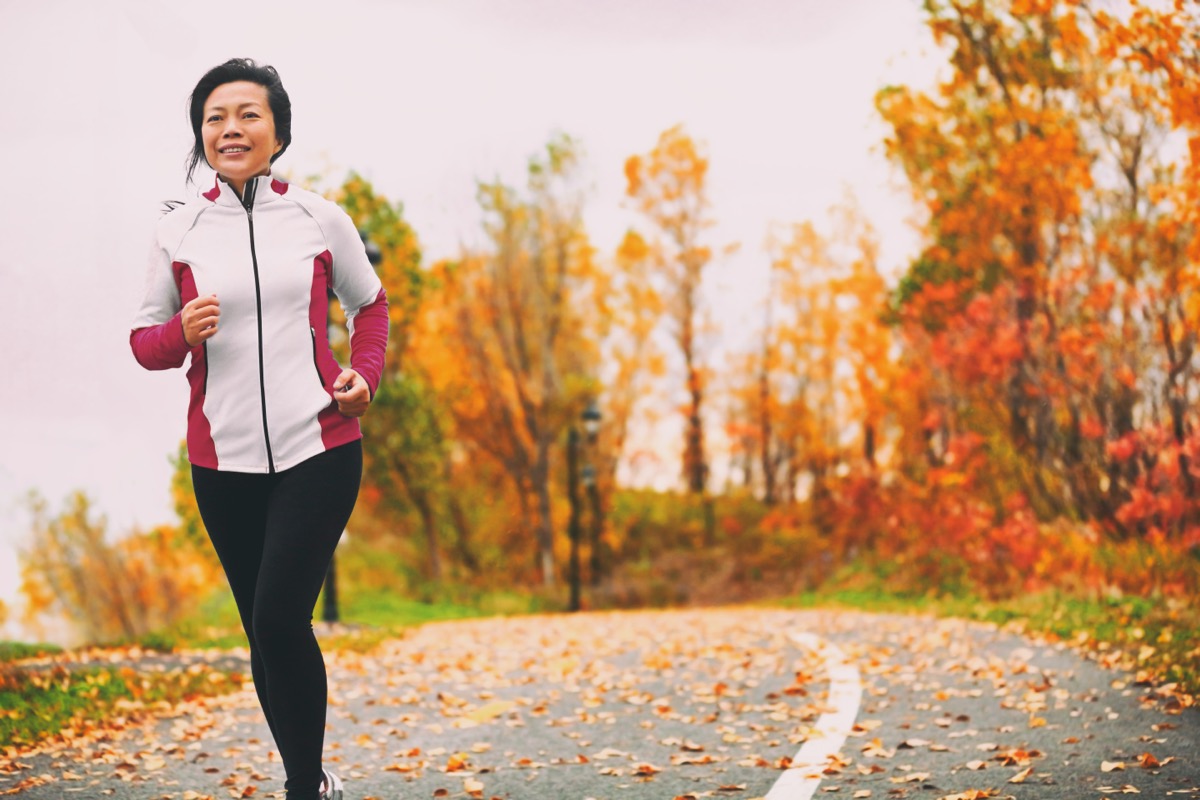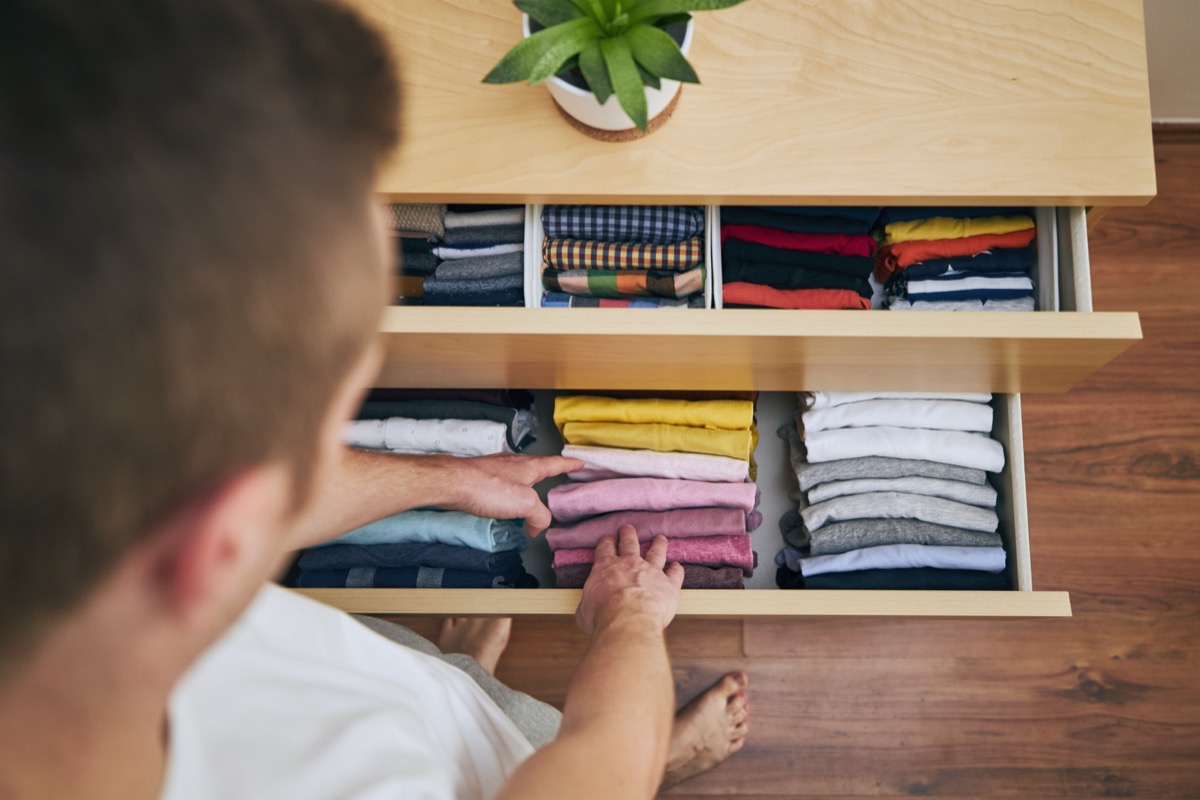10 Clothing Items You Shouldn’t Wear on a Run

What you wear on a run can seriously impact your endurance and experience. Comfort is key, of course, but so are a few other practical considerations that people often forget as they’re getting ready to exercise. That’s why we’ve rounded up a group of fitness experts and asked them to share which gear will make or break your training. Read on to learn which clothes you should never wear on a run.
RELATED: 5 Items You Shouldn’t Wear on Hot Days If You’re Over 65.
1
Dark-colored clothes

If you go for a midday run when the sun is at peak intensity, dark blue or black clothing will absorb and trap the heat. To avoid overheating or becoming dehydrated, experts say it’s better to opt for lighter-colored clothing, which reflects the sun’s rays.
Louise Hateley, a physiotherapist and the director of In Stride Health Clinic, adds that if you run in the early morning or at night, there’s another major benefit to wearing lighter-colored clothing: better safety on the road. “Wearing dark clothing increases your danger of being hit by an automobile since you will be less visible to drivers,” she warns.
2
Cotton apparel

Soft, durable, breathable, and natural, cotton is an excellent material for everyday wear. However, experts say that running in cotton gear can leave you feeling uncomfortable, especially when it’s hot outside.
“Cotton absorbs your sweat and doesn’t dry quickly. This can lead to chafing and discomfort,” says Nolwan Cameron, a NASM-certified personal trainer and fitness coach who contributes to My Phenom Fitness.
Instead, try moisture-wicking fabrics and quick-drying fabrics such as polyester, nylon, merino wool, or bamboo.
RELATED: If You’re Over 65, Don’t Wear These 5 Clothing Items When Traveling.
3
Cotton socks

Deniz Efe, founder of Fitness Equipped, adds that wearing cotton socks can cause additional problems. “While comfortable for daily wear, cotton socks aren’t suitable for running,” he says. “They absorb and retain moisture, which can lead to blisters. Opt for moisture-wicking socks instead.”
4
Old running shoes

Choosing the right pair of running shoes is one of the most important things you can do to ensure a good run. The optimal pair will have good cushioning, arch support, stability, and comfort.
“Running puts a lot of repetitive stress on your feet, and good running shoes that fit you well and have been broken in are the best way to keep this stress from leading to injury,” says Caroline Grainger, an ISSA-certified personal trainer at Fitness Trainer. “Only wear your running shoes when you go for a run, and take the time to break in a new pair of shoes with a shorter run first.”
RELATED: 8 Surprisingly Effective New Jogging Tips, According to Fitness Experts.
5
Earbuds

Many people enjoy listening to music or a podcast while they run, but Grainger advises against wearing earbuds unless you’re in an especially safe running environment.
“I definitely love to listen to music when I’m working out, but sometimes it’s a better idea to avoid headphones or earbuds on your run,” the trainer tells Best Life. “This is especially important if you’re running in a high-traffic area where you’ll need to listen for passersby and honking horns, as well as if you’re running in a high-crime area, especially by yourself.”
6
Loose shorts

The fit of your clothing is also an important consideration when you’re going for a run. Efe recommends skipping shorts that are too loose, opting instead for well-fitting shorts with an inner lining.
“While they may seem breezy and comfortable, loose shorts can cause chafing during a run. It’s better to select shorts that are snug, but not tight,” he tells Best Life.
RELATED: The Best Times of Day to Walk for Your Health, Experts Say.
7
Unsupportive sports bras

Supportive undergarments, including effective sports bras, are an essential part of your running kit. In fact, one recent study found that certain sports bras change the way women run.
“For those who need them, an unsupportive sports bra can lead to discomfort and potential ligament damage. Always opt for a well-fitted, supportive sports bra for running,” advises Efe.
According to Adidas, several red flags could suggest that your sports bra is the wrong size. If the cups don’t cover your whole breast, the straps dig into your shoulders, or the band is too loose or too tight around your ribcage, you should head back to the store and try again.
8
Heavy or bulky jackets

If you go for a run in cold weather, a jacket is an appropriate addition to your outfit. However, heavier jackets can increase your risk of dehydration and exhaustion, so it’s best to opt for a running jacket made specifically to be lightweight and breathable. A good rule of thumb is to always dress as though it’s 10 degrees warmer than the true temperature outside, experts say.
“A light drizzle or cooler temperature might tempt you to grab that thick jacket. However, as you heat up, it becomes cumbersome and can trap heat, making you feel overheated,” Cameron says.
RELATED: If You’re Over 65, Don’t Wear These 6 Clothing Items to Exercise.
9
Jewelry

Jewelry—especially loose necklaces—should also stay home when you go for a run. “While that pendant might have sentimental value, it can swing and become a distraction or even lead to injury,” says Cameron.
Depending on the intensity of your exercise and the quality of your jewelry, you may also damage your favorite pieces if you’re not careful.
10
Everyday underwear

The underwear you don for your workday or to the grocery store is best left at home when you go for a run, says Cameron. This is especially true for men who typically wear cotton boxers, which provide no built-in support.
“It’s worth investing in moisture-wicking, athletic underwear,” the fitness coach says. “Trust me on this—regular ones tend to retain moisture and can lead to that dreaded chafing.”
For more fitness tips sent directly to your inbox, sign up for our daily newsletter.